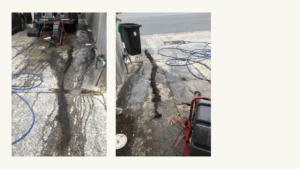A blocked drain can present a whole range of problems, from overflows to leaking pipes and more. If you’re wondering how to deal with a blocked drain, click here for comprehensive guidance on fixing the issue.

What Causes Blocked Drains?
Blocked drains can be caused by anything from waste build ups inside the pipe or a foreign object blocking the exit. It’s essential to identify the source of the blockage to then apply an appropriate solution. Some common causes of blocked drains include:
- Tree roots
- Leaves and other natural debris
- Silt in pipes due to improper construction
- Hair, hygiene products and residue down the sink
- Food waste stuck in sewer grates and pipes
- Grease build up around the pipework
Identifying the Problem
When dealing with blocked drains, it’s important to assess the problem before attempting any DIY solutions. Consider where the blockage is located; is the issue in the kitchen, bathroom or another area? Knowing the location helps narrow down the source of the blockage.
It’s also important to inspect the garden outside to see if there are any visible signs of sewage leakage or sudden changes in terrain. This can help make sure that your plumbing problem isn’t deeper than what meets the eye.
Common DIY Solutions
If you’re looking to take care of the blocked drain yourself, there are a few simple DIY solutions you can use. To start, the first step is usually to try plunging the drain. This involves using a plunger attached to a small water bottle filled with warm water to create a vacuum effect, forcing any blockages out of the drain.
Boiling water and soda crystals are often used to break down fatty deposits and soap scum that may be clogging the drain. However, it is important to keep in mind that this method shouldn’t be used if your drains are connected to septic systems as they can corrode and damage the system over time.
Once the blockage has been removed, it’s always good practice to incorporate regular maintenance into your households routine. This includes cleaning and checking areas such as sink traps, shower traps and outside drains to ensure that potential problems can be identified and resolved quickly.
Call in the Professionals
It’s highly recommended to call professional drainage services for larger blockages and more complex issues. Experienced plumbers can easily diagnose and fix the problem, as well as providing advice on what to do if similar problems arise in the future.
Local experts can provide a wide range of specialist services such as hydro jetting, camera inspections and other related services to properly unblock the drains and ascertain the underlying cause of the issue. This ensures that it does not reoccur in the near future.
Preventative Measures
The best way to avoid blocked drains is to take preventative measures. Home-owners should be conscious of what is going down their drains and avoid putting any items such as hairs, grease or large food pieces down the drain. Also, regularly inspect your drain for any potential issues such as root intrusions.
Furthermore, installing in-line filters and periodic maintenance will reduce the chances of major blockages due to the accumulation of sediment in the pipes.
Overall, when dealing with blocked drains there are a variety of methods available depending on the severity and complexity of the issue. Self-assessment and basic DIY methods are great starting points, however if these don’t work it’s important to seek cut professional help. Once the problem is resolved, regular maintenance and preventative steps will help minimise the risk of it happening again.







